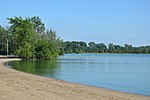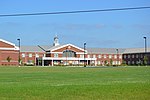St. Patrick's Catholic Church (Glynwood, Ohio)
1857 establishments in Ohio19th-century Roman Catholic church buildings in the United StatesChurches in Auglaize County, OhioChurches in the Land of the Cross-Tipped ChurchesChurches in the Roman Catholic Archdiocese of Cincinnati ... and 5 more
Gothic Revival church buildings in OhioIrish-American culture in OhioNational Register of Historic Places in Auglaize County, OhioReligious organizations established in 1857Roman Catholic churches completed in 1883

St. Patrick's Church is an historic Roman Catholic church in Glynwood, an unincorporated community in Moulton Township, Auglaize County, Ohio, United States.: 45 Located north of U.S. Route 33 between St. Marys and Wapakoneta,: 45 the church was built in 1883 in the Gothic Revival style. It is one of many large Catholic churches in a region of rural western Ohio known as the "Land of the Cross-Tipped Churches," which was settled by primarily Catholic immigrants during the nineteenth century.: 2, 6
Excerpt from the Wikipedia article St. Patrick's Catholic Church (Glynwood, Ohio) (License: CC BY-SA 3.0, Authors, Images).St. Patrick's Catholic Church (Glynwood, Ohio)
Glynwood Road,
Geographical coordinates (GPS) Address External links Nearby Places Show on map
Geographical coordinates (GPS)
| Latitude | Longitude |
|---|---|
| N 40.583055555556 ° | E -84.318055555556 ° |
Address
Saint Patricks Catholic Church
Glynwood Road
45885
Ohio, United States
Open on Google Maps









